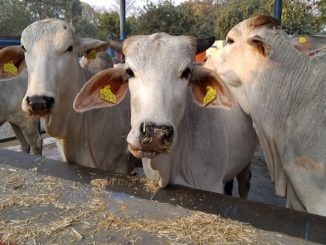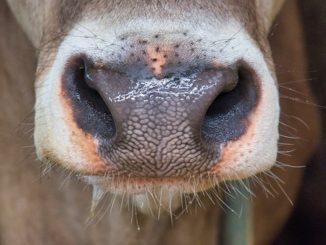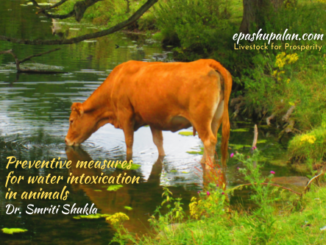Introduction
Mycotoxins are toxic secondary metabolites formed by fungi that naturally grow in a variety of agricultural products and cause a variety of toxic effects in livestock. Aflatoxicosis is the disease condition caused by the consumption of high levels of aflatoxins that caused major health threats and significant economic impact on the livestock industry. Aflatoxins are poisonous, mutagenic and carcinogenic by-products produced by certain fungi that can be found on contaminated agricultural crops and their grain by-products including corn, maize, peanuts, cottonseed, tree nuts, and ground nut cake. These fungi usually grow in the right conditions of humidity, temperature, and suitable substrate. The most powerful mycotoxin that affects animals is Aflatoxin B1. The toxic response and disease in livestock varies in related factors like species, sex, age, nutritional status, length of consumption, and level of aflatoxins in the ration. At low levels of intake, usually there are no visual symptoms of aflatoxicosis, and as such the problem is often unnoticed. However, high concentrations of aflatoxins, or prolonged exposure at low levels, cause visual symptoms in livestock. Aflatoxicosis is clinically characterised by anorexia, unthriftiness, weakness, reduced growth and feed efficiency, icterus, and occasional sudden deaths. Clinical signs are mainly depends on amount of toxins consumption and rate of metabolism. Acute aflatoxicosis is more dangerous which leads sudden death with any visible clinical manifestations. Aflatoxicosis occurs in many parts of the world and affects growing animals like young pigs, pregnant sows, calves, and lambs. Adult animals are relatively resistant to the acute form of the disease but are susceptible to chronic exposure to toxins. Aflatoxin M1 is the natural metabolite of aflatoxin B1 that does not appear to be as carcinogenic or mutagenic as B1. Within 12 hours of consuming, the metabolite M1 appears in milk. Approximately 0.3 to 6.2 % of B1 is converted into M1 and excreted in milk of dairy animals. Contaminated milk cannot be used for human consumption and must be discarded. According to Food and Drug Administration (FDA), the maximum permissible limits for Aflatoxins B1 in dairy feed and M1 in milk are 20 ppb and 0.5 ppb respectively in India. Aflatoxins are converted to an epoxide in the liver, which binds to macromolecules, especially nucleic acids and nucleoproteins. Aflatoxins are toxic by-products of the growth of some species of the mold fungus Aspergillus. When crops are stressed, the risk of aflatoxins rises. Aflatoxin contamination is possible in some crops, particularly whenever drought stress occurs. The strategies to control aflatoxins includes, some processing methods for feed like heat, biological inactivation, the use of microorganisms, and ammonia. Prevention of fungal growth may be more realistic, but chemical detoxification through ammonia does show promise.
Etiology
Aflatoxins are the most common and well-studied group of mycotoxins, and they thrive in warm, humid climates, as exists in India and in many Asian countries. Aflatoxins are produced by Aflatoxin-producing fungi include Aspergillus species, namely A. flavus, A. nomius and A. parasiticus. Aflatoxins are produced on stored agricultural crops and their grain by-products including corn, maize, peanuts, cottonseed, tree nuts, and ground nut cake when moisture content and temperatures are high enough for mould development. This usually entails day and night temperatures of at least 70°F. Before harvest, the risk for the development of aflatoxin is greatest during major droughts, when soil moisture is below average and temperatures are high, the amount of Aspergillus spores in the air increases. These spores infect crops through areas of damage caused by insects, and inclement weather. Once injected, plant stress occurs and production of aflatoxin is favoured. During postharvest stage, proliferation of aflatoxin can be exacerbated in susceptible environment. More than 18 types of aflatoxin occur in nature, but Major forms of Aflatoxins found in feeds include Aflatoxins B1, B2, G1, G2, M1, and M2; with Aflatoxin B1 being the most common and potent carcinogen. Aflatoxin B1 and B2 results in milk residues of aflatoxin M1 and M2 respectively. Small amounts of other derivatives such as aflatoxin M4, Q1, and aflatoxicol can also be found in milk, however aflatoxin M1 is the primary residue. USFDA and BIS (India) stipulate a maximum accepted/residue levels for aflatoxin in animal feeds as 0.02 mg/kg or 20 ppb, which means that one ton of feed should not contain more than 20 milligrams of Aflatoxin, while it is 0.005 mg/kg in complete feeding stuffs for dairy animals and 0.01 mg/kg for complete feeding stuffs for calves and lambs. The FDA sets limits on aflatoxin in corn grain according to intended use of the grain, including 20 ppb or less for lactating dairy cattle, 50 ppb or less for weaner pigs, 100 ppb or less for calves, 200 ppb or less for breeding cattle/finishing pigs, and 300 ppb or less for finishing or beef cattle. The United States Food and Drug Administration (USFDA, 2018) and Food Safety and Standards Authority of India (FSSAI, FSS Regulation 2011) set a maximum permissible level for Aflatoxin M1 in milk at 0.5 ppb of milk, which means that one ton of milk should not contain more than 500 micrograms of Aflatoxin M1.
Toxicity and Pathogenesis
The dose of aflatoxin required to produce a toxic effect is not the same in all animal species. It varies depending on the animal’s breed, sex, age, period of feeding, nutritional status of animal and environment. Animals that are subjected to environmental or production stress can exhibit more severe symptoms. During heat stress, fescue toxicity manifests itself in more pronounced symptoms. Cattle and sheep are more resistant to aflatoxin effects, likely due to ruminal microbial degeneration. Beef and dairy cattle are more susceptible to aflatoxicosis than sheep and goats, whereas, young animals of all species are more sensitive than mature animals. On the other hand, pregnant and growing animals suffer from aflatoxicosis less than young animals, but more than mature animals kept at maintenance e.g. breeding males. In swine, young pigs are more sensitive, followed by pregnant sows and feeder pigs. Adult animals are relatively resistant to the acute form of the disease but are susceptible if toxic diet is feed over long periods. Aflatoxins are metabolized in ruminants by the liver and excreted in the bile. Toxins are degraded enzymatically in the liver through the mixed function oxidase system (MFO). The detoxification process is thought to be aided by the MFO system, which converts toxins into a more polar form. However, in aflatoxicosis, the MFO system in the liver appears to oxidise the aflatoxin to another metabolite that interacts with the nucleolus protoblast’s chromatin, impairing the chromatin’s template function to generate M-RNA. The majority of research suggests that the main cytotoxic effect is caused by interaction with messenger RNA, though some effects have also been observed with DNA synthesis. Interference with cellular protein synthesis results in a variety of lesions in the animal, the most visible of which are in the liver. Mutagenesis, carcinogenesis, teratogenesis, decreased protein synthesis, and immunosuppression are all toxic effects caused by alkylation of nuclear DNA. Reduced protein synthesis means fewer essential metabolic enzymes and structural proteins are generated, which is bad for development. Aflatoxin high doses cause hepatocellular necrosis, while low doses cause decreased growth rate, immunosuppression, and liver enlargement. Aflatoxin causes a variety of pathologic changes, all of which need to be investigated further. Nephrotoxicity, immunosuppression, and carcinogenicity are among the other lesions. Research suggests M1 is not as carcinogenic or mutagenic as is B1, but it does appear to be as toxic as its parent compound.
Clinical sign and symptoms
Aflatoxicosis has a wide range of clinical symptoms, though the majority of cases go unnoticed due to prolonged exposure and cellular changes in different processes rather than a specific organ. Acute toxicoses with massive doses would lead to death due to hepatic failure with no overt clinical signs. Acute signs, might include anorexia, depression, anemia, ataxia, epistaxis and melena. Chronic aflatoxin poisoning is characterised by feed refusal, poor growth, intermittent diarrhoea, reduced milk production/quality, icterus, reduced feed production and death. Listlessness, weight loss, a rough hair coat, ascites, and nervous signs are all possible side effects in cattle. Nervous signs characterised by ataxia, circling movement, convulsion and blindness. In buffalo the clinical sign include dullness, diarrhoea, emaciation, ascites, anemia and icterus. In pregnant animals abnormal estrous periods (too short or too long), immunosuppression, infertility and abortions are possible side effects of the disease. Impaired immune response, increased susceptibility to other illnesses, and rectal prolapse are some of the other signs. Laboratory changes are related to liver damage, coagulopathy, and impaired protein synthesis. Both conjugated and unconjugated bilirubin may be elevated. Specific laboratory changes include increased liver function test like AST, ALT, and alkaline phosphatase; hypothrombinemia, prolonged prothrombin, activated partial thromboplastin times, hyperbilirubinemia, hypocholesterolemia, hypoalbuminemia, and variable thrombocytopenia. However, there are no consistent diagnostic improvements in hematocrit, haemoglobin, or differential cell counts. However, animals with secondary bacterial infections can develop leukocytosis.
Gross lesions
The level of aflatoxin and length of feeding influence the lesions seen at necropsy, which can be linked to acute or chronic liver disease. The majority of acute liver damage caused by experimentally high doses, while chronic liver damage is more common in the field. The liver usually become enlarge, light tan, purple, or orange in colour. Hepatic fibrosis and gallbladder oedema are also possible. Petechiae or more generalised haemorrhage, edema of the gall bladder, pale necrotic kidney and hydropericardium are all findings of gross lesions.
Microscopic findings
Microscopic lesions mostly observe on liver that depends on the dose and duration of exposure, including fatty change, biliary epithelial proliferation, hepatocellular degeneration, necrosis in the centrilobular zone and hepatocytes, which are typical of aflatoxicosis.
Diagnosis
Diagnosis of aflatoxin could be based on history of feeding with contaminated food. Milk tests reveal the presence of aflatoxins in milking cows. Non-lactating cattle, on the other hand, are more difficult to diagnose because of the wide range of clinical symptoms, gross anatomy, and the prevalence of other diseases due to immune suppression. Complete laboratory submission for diagnosis should include suspect grain or feed, fresh liver, kidney and urine in case of dead animal. A portion of liver, kidney and other organs should be put in formalin for microscopic examination. In the case of sick animal, a serum sample for a liver function test and contents of the rumen or stomach are useful. In infected feed on the farm, more than one fungus or toxin may be present, making a conclusive diagnosis of aflatoxicosis difficult. However, due to their low concentration in foods and feedstuff, analytical methods for detection and quantification of aflatoxins have to be specific, sensitive, and simple to carry out. Several methods including, Thin layer chromatography (TLC), High performance liquid chromatography (HPLC), Pressure mini column technique, Fluorescence spectrophotometry, ELISA and electrochemical immunosensor. ELISA and HPLC are widespread technique for quantitative detection of aflatoxins. Fluorescence has been used to analyse aflatoxins in grains and is very useful in the characterization and study of molecules that emit energy at particular wavelengths. In less than 5 minutes, the fluorometric method can detect aflatoxin levels ranging from 5 to 5000 ppb.
Prevention
Aflatoxicosis can only be avoided by feeding non-aflatoxin rations. A continuous and rigorous sampling and testing programme is needed to prevent aflatoxin contamination. An attempt should be made to minimise the adverse effect of aflatoxins. These can be achieved in the following ways.
- Buy feed from reputable individuals and businesses that are knowledgeable about aflatoxin prevention and have a track record of closely tracking their feed products. A reputable feed provider would have insurance in place to cover any mishaps with aflatoxins or other issues.
- Avoid purchasing low-quality feed or feed products. If a good offer on feed prices turns out to contain aflatoxin, it may be the most costly purchase a dairy farmer ever makes.
- To prevent mould growth in feed, organic acids such as propionic, sorbic, and benzoic acids, as well as their salts such as calcium propionate and potassium sorbate, and copper sulphate, can be used.
- By adding more protein, methionine and liver preparation in the feed will reduce the effect of aflatoxins on animals.
- Keep the moisture level of feed lower as the high moisture content in feed favour the growth of flavus. Safe moisture level of maize and cotton seed include 15% and 11% respectively.
- Expose the feed in the sunlight for 2-3 days help to maintain moisture level.
- Develop a comprehensive inspection and clean-up programme to prevent feed ingredients from adhering to containers, delivery vehicles, and other equipment.
- Reduce the amount of dust in the milling and mixing fields. Ensure that all feed equipment is free of caked feed.
- In the grain storage areas, implement successful rodent and insect control systems.
- Alfatoxin contaminated grains have been successfully treated with ammonia. It breaks the double oxygen bond and chemically alters and destroys aflatoxin but the process is costly and risky. It is also not currently approved by the FDA for use in food animals. For ammonia treatment grain should have 13% moisture and above 60°F but the process is costly and risky. Ammonia for grain treatment can be gaseous (NH3) or liquid (aqua-ammonia, NH4OH). Aqua ammonia is 26 – 29 % ammonia at standard atmospheric pressure and temperature. Use 2.6 to 2. 7 pounds of aqua-ammonia per bushel of corn for the 1.5 percent treatment rate. Adding this much moisture may require drying for storage after treatment.
- Regular check for leaks in feed storage bins along with check the ration meticulously before inclusion as ration.
- To prevent the growth of fungus, Antifungal agents like propionic acid, calcium propionate can be added at the rate of 2-8 kg/ton of feed.
- Microbial treatment of feed also reduce the aflatoxins content. Microorganisms especially mold and yeasts have the opportunity as bio-competitor for parasiticus and control the problem of aflatoxin contamination. For this add Saccharomyces cerevisiae @ 0.05-1% in feed.
Treatment
Aflatoxicosis is usually a herd problem rather than a problem with a single animal. Treatment should be focused on the herd’s most critically infected animals, and further poisoning should be avoided. Young, newly weaned, pregnant, and lactating animals require special protection from suspected toxic feeds. The ration should be analysed right away if aflatoxicosis is suspected. If aflatoxins are found, the origin should be removed as soon as possible. Numerous products are marketed as anticaking agents to sequester or bind with aflatoxins and reduce absorption from the GI tract. One effective binder for aflatoxins is hydrated sodium calcium aluminosilicates (Natural DE) as well as mineral clays such as zeolite and bentonite, which reduce the effects of aflatoxin when fed to cattle, buffalo or pigs at 500-1000 gm/ton can bind to aflatoxin and prevent animals from absorbing it. Anticaking agent also reduces aflatoxin M1 levels in milk by 50%, but does not remove aflatoxin M1 residues in milk from dairy cows fed aflatoxin B1. Recently modified glucan based adsorbents have also been developed and marketed (Mycosorb™, Alltech). They may be similarly effective as the aluminosilicates and are used at lower levels in feeds. Timely administration of methionine (200mg/kg) and sodium thiosulfate (50mg/kg) at 8 hour intervals is proven to be of therapeutic value. Since the toxin binds vitamins and affects protein synthesis, supplementation with increased levels of high-quality protein, vitamins (A, D, E, K, and B) and liver tonic (Livotas) can also be useful. To reduce the risk of secondary infections, good stress management practises are important. Secondary infections must be addressed and treated right away.
Conclusion
Aflatoxins, at high doses or in the long term, can cause acute or chronic health problems in a dairy herd. Aflatoxin can significantly affect animal health and productivity even when fed at nonfatal levels. Aflatoxins are a factor contributing to chronic problems, including a higher incidence of disease, poor reproductive performance, or sub optimal milk production. For lactating dairy cattle, aflatoxin level do not exceed 20 ppb in ration. There is a lot that can be done if dairy farmers and feed manufacturers are aware of feed protection. Various materials can bind mycotoxins in feed and thus reduce toxic exposure to consuming animals. Animals may also be supplemented with antioxidants and other beneficial substances. Responses in dairy cattle to some of these products have been very encouraging. Fungus growth would be inhibited by a wide spectrum mould inhibitor in concentrate feed between the time of manufacture and the time of consumption.
References
- Adams, R. S., K. B. Kephart, V. A. Ishler, L. J. Hutchinson, and G. W. Roth (2017). Mold and mycotoxin problems in livestock feeding. Penn State Extension Publication DAS93-21.
- Food & Drug Administration (2016). Guidance for Industry #203: Ensuring safety of animal feed maintained and fed on-farm.
- Maki, C. R., A. D. Thomas, S. E. Elmore, A. A. Romoser, R. B. Harvey, H. A. Ramirez-Ramirez, and T. D. Phillips (2016). Effects of calcium montmorillonite clay and aflatoxin exposure on dry matter intake, milk production, and milk composition. J. Dairy Sci. 99:1039-1046.
- Abd-Elghany S. M., Sallam K. I. (2015). Rapid determination of total aflatoxins and ochratoxins A in meat products by immuno-affinity fluorimetry.Food Chem. 179 253–256.
| The content of the articles are accurate and true to the best of the author’s knowledge. It is not meant to substitute for diagnosis, prognosis, treatment, prescription, or formal and individualized advice from a veterinary medical professional. Animals exhibiting signs and symptoms of distress should be seen by a veterinarian immediately. |









1 Trackback / Pingback